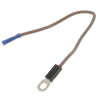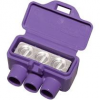Hello,
Reading tech articles and upgrades can be dangerous. I haven't checked the red connector yet, but given the age, I suspect there will be signs of overheating. Then I read Ignition Bypass mod. Hmmm. The RWB seems more needed, lots of failures. The Ignition Relay seems like overkill, also adding several other failure points, and failures don't appear as prevalent in the searches I've done. Additionally, why is there a 70amp relay needed, and then it's wired to a 12gauge wire? The factory wires seem smaller than that as well. I'm not "electrically inclined" but a 70 AMP relay is hugely oversized or the wiring is hugely undersized? Or not? Thoughts?
RT
You don't need a 70 amp relay. A 40 amp relay will suffice. I used this one:
High quality relays manufactured in Japan, by Panasonic EW/NAIS- Matsushita, and Mistuba. Motorcycle electrical wiring harness relay components, Relay base holder and sockets, for ISO Micro and Mini relay's, Electronic LED flasher relay's. Great Prices, and Cheap Shipping.

www.cycleterminal.com
The Red Wire Bypass is a band-aid, and not a very good one at that. You are just trading one crimp for another (actually, you are trading one crimp for THREE crimps!) and it doesn't fix the problem. It may work long enough or not, so you are not giving yourself any peace of mind. A number of people have had a meltdown despite doing the Red Wire Bypass.
Here is a different way to do the fuse box part of the Ignition Relay Bypass Mod without cutting any wires:
I'm am planning a long trip next year that will find me in the boonies from time to time, so I figured it was time to address the red wire issue that plagues the ST1100. It appears there are two approaches; the "red wire bypass" and the "ignition relay bypass". The "red wire bypass" really...

www.st-owners.com
On your bike there are four wires going into the fuse box that are switched.
Wire 1: Headlight (20A, Red/Black)
Wire 2: Neutral, Oil, Temp, Tacho, Horn (10A, also Red/Black)
Wire 2: Position, Meter Light, Tail (10A)
Wire 2: Ignition, Starter, Alternator (10A)
Wire 2: Turn Signal, Brake (10A)
Wire 3: Fan Motor (10A, Blue/Orange)
Wire 4: Accessory (5A)
If you just bypass wires 1 and 2, then the only things that will be left on the red wire are the fan motor and the clock. If you are using the accessory terminal to power something, then add five amps max, but still no problem.
If you take your time and do all your own crimps, then failure points shouldn't be a worry. Remember, you are eliminating failure points by doing the mod.
Jeff



 .
.


